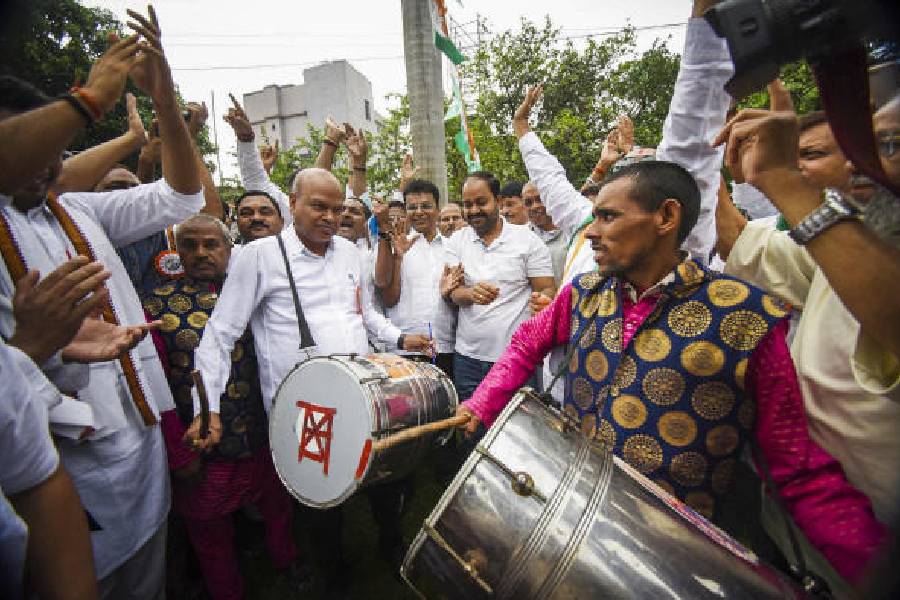 |
 |
 |
| (From top) Actress Swastika Mukherjee sports a look put together by designer Agnimitra Paul for the forthcoming film Nayak; Koel Mallick and Jeet in the designer’s creations; Agnimitra at her studio. Pictures by Pabitra Das. Swastika’s make-up by Anirudhha Chakladar |
If the success route leads from Tollywood to Bollywood for most, here’s someone who decided to take it the other way round. Fashion designer Agnimitra Paul, one of the very few mainstream stylists creating wardrobes for Bengali movies, got her first break in the film industry with the Esha Deol debut Koi Mere Dil Se Poochhe back in 2002. The wardrobe she created for Esha for the film won her appreciation from various quarters, including actress Sridevi and directors Satish Kaushik and Subhash Ghai. It was the taste of success in Bollywood that prompted the decision to turn her attention to the film industry back in Calcutta.
“I was designing Sridevi’s personal wardrobe for quite some time and through her I landed the assignment of doing Esha’s wardrobe for Koi Mere Dil Se Poochhe. After that I had talks with other directors and producers there but they all wanted me to stay in Mumbai and have my workshop and other operations there. But it was not possible for me to settle in Mumbai due to personal reasons. So I had to give up the idea,” she recalls.
Agnimitra then decided to lend her creative skills to Bengali films, a territory avoided by most other fashion designers. “I felt the scope in Tollywood was immense. Most designers don’t want to work for Bengali films as it doesn’t promise big money. So I thought that there is a lot of scope to work here and things are bound to change once actors, producers and directors become aware of the fact that having a designer wardrobe adds a lot of value to a film,” she says.
Agnimitra’s first Tollywood venture Bandhan, starring Jeet and Koel Mallick, gave her ample scope to express her creativity. “I had to do 70 costumes each for Jeet and Koel. Since Koel had a double role with the two characters being diametrically opposite, their wardrobes had to be very different. It was a challenge and luckily for me the film was a hit and my clothes got noticed,” she smiles.
She attributes a lot of her success in Bandhan to the “creative freedom” offered by Venkatesh Films, the production house. “They gave me full freedom and money was never a problem. The budget for costumes in Bandhan was much more than an average Bengali film,” she adds.
Not only did Bandhan launch Agnimitra in Tollywood, it also ensured that she bagged assignments for most films starring Jeet and Koel. So it was Prabhat Roy’s Manik next, with the same lead pair.
The pretty young lady, who retails under her label Inga, has her platter full right now with designing assignments for three films. She is currently working on costumes for Swastika Mukherjee and Sayantani for Sujit Guha’s Nayak. And the wardrobe for Swastika, says Agnimitra, is one of the most challenging projects she has done till now. “Swastika plays a sex worker in the film and so I had to do her wardrobe accordingly. I’ve used lots of rolex saris, puff-sleeved blouses, cheap-looking zari and loud colours to give her the look,” she reveals.
The other films in her kitty are Biresh Chatterjee’s Sathi Hara starring Jeet and Swastika and an untitled one by Swapan Saha with Koel and Jeet once again. “I’m also very excited about the Swapan Saha film. I’ll give Koel the most glamorous look she has sported till now,” she promises.
The Bengali film industry has finally woken up to the fact that a designer wardrobe lends a swank look to a film, says Agnimitra. And she feels that some of the stars are responsible for this new realisation. “Some actors and actresses try to convince the directors and producers that they want designers to do their wardrobes. They refuse to wear clothes hired from dresswallas or picked up randomly from the market,” she says.
But it’s still a long way to go before the total makeover happens. “Budget is still a very big problem and that’s why the look suffers. A film requires around 20 costumes each for the hero and heroine and it’s difficult to put together the wardrobes for anything less than Rs 40,000 to Rs 60,000. Producers often ask me to use cheap materials, but they don’t understand that poor quality shows on screen. But the mindset is changing fast,” Agnimitra observes.










